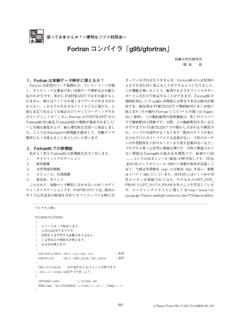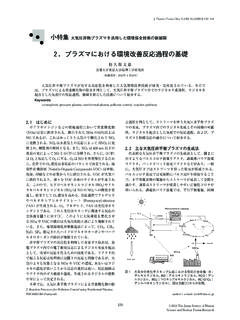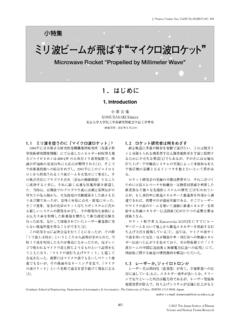Transcription of Dechuck Operation of Coulomb Type and Johnsen ...
1 Plasma and Fusion Research: LettersVolume 3, 051 (2008) Dechuck Operation of Coulomb Type and Johnsen - rahbek Type ofElectrostatic Chuck Used in Plasma ProcessingGyu Il SHIM and Hideo SUGAI1)Department of Electrical Engineering and Computer Science, Nagoya University, Nagoya 464-8603, Japan1)Department of Electronics and Information Engineering, Chubu University, Kasugai 487-8501, Japan(Received 17 June 2008/Accepted 24 July 2008)Comparative study on Coulomb type and Johnsen - rahbek type of electrostatic chuck used for holding asilicon wafer in plasma processing is presented. The remarkable differences between the two types are found indechuck Operation where a high voltage applied to the chuck electrode is turned offto release the wafer fromthe chuck stage.
2 In case of the Coulomb type, an instantaneous large short-circuit current flows exponentiallydecreasing with a short time constant ( = ms). In case of the J-R type, a non-exponentially decaying smallcurrent is sustained for much longer time ( 1000 ms), thus giving rise to the considerable delay of wafer mechanism of such decay is explained by a microscopic bi-layer model where the interfacial layer is dividedinto three distinct regions having their own capacitance and surface 2008 The Japan Society of Plasma Science and Nuclear Fusion ResearchKeywords: electrostatic chuck, Johnsen - rahbek effect, electrostatic Dechuck , surface resistivity, bi-layer modelDOI.
3 Many plasma process applications, electrostaticchuck (ESC) is used as a standard industrial tool for tightlychucking the object (silicon wafer) on a stage and Dechuck -ing it after processing. In a bipolar ESC configuration, ahigh voltage is split between the two plates embedded in-side the chuck stage. On the other hand, a unipolar config-uration is more commonly employed where a positive ornegative high-voltage is applied between the chuck elec-trode molded in the ceramic stage and the grounded plasmavessel. Here the attractive Coulomb force yields betweenthe electrode and the wafer by surface charges of oppositepolarities just as in a two electrode capacitor.
4 In the unipo-lar configuration, charging and discharging currents flowthrough plasma contacting the wafer. The wafer dechuckis done by switching offthe high voltage in a presence ofplasma, and after the charge extinction the wafer is liftedup by pins in the absence of plasma. In volume produc-tion of plasma-assisted semiconductor process, a numberof silicon wafers are required to be speedily chucked anddechucked with use of a load-lock types of ESC are conventionally employed in in-dustry; Coulomb type [1 3] using insulating spacer layer(volume resistivity >1014 -cm), and Johnsen - rahbek (J-R) type[4, 5] using semiconductive spacer layer ( =1010-1012 -cm) between the plates ( , chuck electrodeand wafer).
5 In the J-R type, very strong holding force isachieved at lower chuck voltages than in the Coulomb type,owing to the J-R effect [6]: high electric fields appears atthe metal-semiconductor interface with surface irregular-ities. Thus, the J-R type has an advantage of less arc-author s e-mail: troubles in high-voltage chuck Operation while a largeleakage current flowing in the chuck system may causedamages in the film on wafer. In Dechuck Operation , thewafer held by the Coulomb type ESC is easily detachedafter turning offthe chuck voltage, however in case of theJ-R type the electrostatic charges remain for a long timeand wafer crack troubles sometimes occur during lift bypins for wafer avoid such troubles, a deeper understanding ofthe J-R type ESC is required, particularly on Dechuck -ing Operation .
6 Concerning the chuck Operation of J-Rtype, we previously reported remarkable effects of RF-induced self-bias voltage [7] and a bi-layer equivalent cir-cuit model [8] which successfully explained the behaviorof the J-R chuck. In this paper, we focus on the dechuckoperation, clearly demonstrating the difference betweenthe Coulomb type and the J-R experiment was performed in an ICP device [9]where plasma is produced in a cylindrical stainless steelchamber, by MHz RF discharge in argon at a typ-ical pressure of Torr. In order to compare the twotypes of ESC, we prepared the Coulomb chuck made ofalumina (Al2O3, 5 1016 -cm) and the J-R chuckmade of aluminum nitride (AlN, n-type semiconductor, 2 1010 -cm).
7 Both ESCs have the same geo-metrical sizes: the diameter of 200mm, the thickness of5 mm wherein the chuck electrode made of molybdenumis embedded with the separationl= (spacer layerthickness) from the contacting wafer surface. The geo-metrical contact area of ESC is 60% of the projected areaof chuck electrode, owing to a number of emboss (heightc 2008 The Japan Society of PlasmaScience and Nuclear Fusion Research051-1 Plasma and Fusion Research: LettersVolume 3, 051 (2008)50 m, area 2 2mm2) prepared for helium gas cooling of all, the Coulomb type ESC was installed witha 200-mm-diam silicon wafer in the ICP chamber. In theactual plasma processing, the chuck voltage is applied af-ter plasma ignition where the wafer at the floating potentialis electrically connected with the grounded chamber viaplasma.
8 In the present experiment, to make the problemsimple and to avoid RF noise for small current measure-ments, the wafer was short-circuited to the ground by ametal wire in vacuum without plasma, and the voltage ofV0=1 kV was applied to the chuck electrode to hold thewafer. After then, the wafer was dechucked by switchingoffthe applied voltage at the timet=0, and the chuck cur-rentIwas measured together with the chuck semi-logarithmic plot in Fig. 1 indicates the ex-ponential decay ofIandVwith the same time constant of = This behavior is understood considering theequivalent circuit inserted in Fig. 1 (a). With the switch S1turned on and S2off, the chuck capacitanceCis filled withcharges, which are discharged in Dechuck Operation withS1offand S2on at the timet=0, yielding the currentI(t) via the external resistanceR0connected to the chuckvoltage source.
9 A simple circuit analysis gives the expo-nentially decaying current with the time constant =CR0asI(t)=(V0/R0)exp( t/ ).(1)The measured current atV0=1 kV in Fig. 1 (b) gives theinitial valueV0/R0=40 mA att=0, which leads toR0=25 k in accordance with the installed resistanceR0=23 k . Furthermore, the measured time constant( = ms) allows us to estimate the capacitance to beC= /R0= nF. On the other hand, the calculationFig. 1 (a) Chuck voltageVand (b) chuck currentIin dechuckoperation of Coulomb type a well-known formula of parallel electrode capaci-tance gives slightly smaller value:C= 0 SS/l= nFfor the specific dielectric constant of alumina S= ,the areaSof 200-mm-diam.
10 Wafer, andl= nF, the initial chargeQ0is estimated asQ0=CV0= C , along with the chuck holding forcebefore Dechuck to beF0=(D2/2 0)S= displacementD=Q0/S. The estimated holdingforce agrees with the measured valueF0 40 N based ona helium gas pressurization method[8].The remarkably different behaviors were found indechuck Operation of the J-R type as shown in Fig. the chuck voltage ofV0= is turned offatt=0, a non-exponentially decreasing small current con-tinues for long time ( 1000 ms). It should be noted thatthe time scale of horizontal axis of Fig. 2 is three orders ofmagnitude larger compared with Fig. 1. The temporal vari-ation of currentIin Fig. 2 (b) can be fitted by superposingthree exponentially decaying currents with different timeconstants 1=39 ms, 2=260ms and 3=580ms asindicated by the dashed lines, although the measured slopedI/dtcontinuously and smoothly changes in time.









